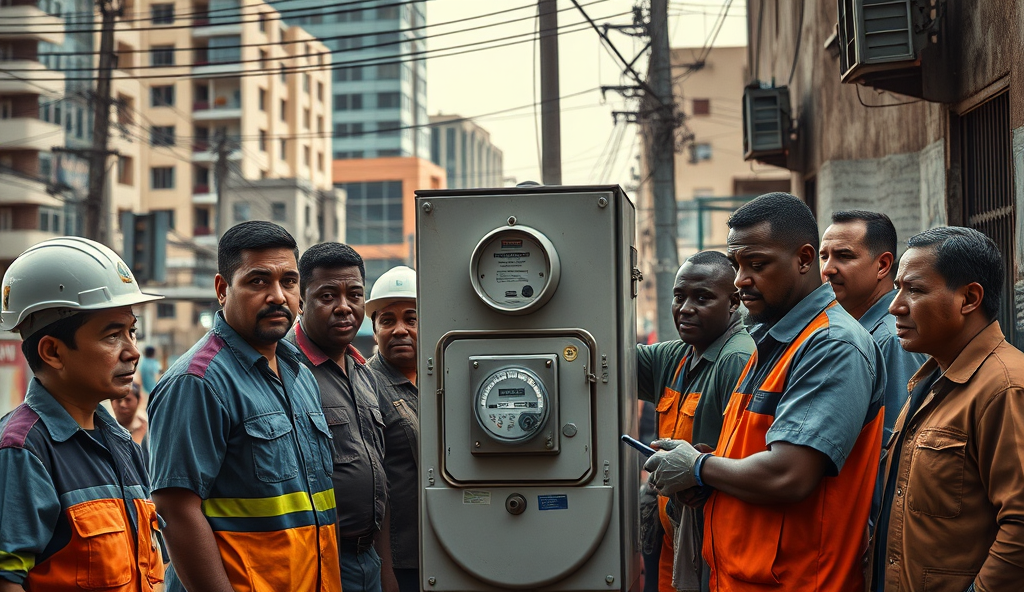Introduction to the Electricity Tariff Hike in Nigeria
The recent electricity tariff hike, approved by NERC in April 2024, marks a 240% increase for Band A consumers, directly impacting households and businesses across Nigeria. This adjustment follows years of subsidy reductions and aligns with Nigeria’s power sector reforms aimed at improving infrastructure and service delivery.
For context, Lagos residents now pay ₦225 per kWh, up from ₦68, while Abuja consumers face similar spikes, straining already tight budgets. The tariff revision reflects rising generation costs and Nigeria’s energy cost crisis, compounded by gas shortages and grid inefficiencies.
As we explore the new tariff structure next, understanding these foundational changes helps contextualize their broader implications for monthly bills. The hike’s ripple effects extend beyond pricing, influencing consumption patterns and economic stability nationwide.
Key Statistics

Understanding the New Electricity Tariff Structure
The recent electricity tariff hike approved by NERC in April 2024 marks a 240% increase for Band A consumers directly impacting households and businesses across Nigeria.
The revised tariff structure categorizes consumers into bands (A-E) based on daily power supply hours, with Band A (20+ hours) facing the steepest hike to ₦225/kWh. This tiered approach aims to reflect actual service quality, though many Nigerians question the reliability of their assigned bands given persistent grid failures.
For example, a Lagos household consuming 200 kWh monthly now pays ₦45,000, up from ₦13,600—a 230% surge that disproportionately affects middle-income earners. Businesses in Abuja report similar shocks, with some manufacturers seeing energy costs leap from 15% to 40% of operational expenses.
These changes stem from NERC’s cost-reflective tariff model, which we’ll analyze next by examining the key drivers behind the adjustment. The structure’s viability hinges on improved service delivery, yet consumers face higher bills without guaranteed supply stability.
Factors Influencing the Tariff Increase
The revised tariff structure categorizes consumers into bands (A-E) based on daily power supply hours with Band A (20+ hours) facing the steepest hike to ₦225/kWh.
The tariff hike primarily stems from Nigeria’s shift to a cost-reflective pricing model, which aims to reduce government subsidies and align electricity prices with actual generation costs. For instance, the federal government spent ₦375 billion on subsidies in 2023, a burden NERC seeks to ease by transferring costs to consumers with higher consumption capacity.
Rising operational expenses, including gas prices and distribution infrastructure maintenance, further justify the adjustment. DisCos cite a 40% increase in gas-to-power costs since 2022, compounded by currency devaluation, which makes imported equipment more expensive.
Grid modernization investments and Nigeria’s energy transition plan also contribute, though consumers bear the brunt before seeing service improvements. This sets the stage for examining how different consumer categories—from households to manufacturers—are impacted by these changes.
How the Tariff Hike Affects Different Consumer Categories
The tariff hike primarily stems from Nigeria’s shift to a cost-reflective pricing model which aims to reduce government subsidies and align electricity prices with actual generation costs.
The tariff adjustment disproportionately impacts Band A consumers (those using over 20 hours daily), who now pay ₦225/kWh—a 240% increase from ₦66/kWh. Small businesses like Lagos bakeries report 30% higher operational costs, forcing price adjustments or reduced production hours to cope with Nigeria’s energy cost crisis.
Residential users in Bands B-E face moderated hikes but grapple with unreliable supply, as DisCos’ new tariff structure Nigeria still doesn’t guarantee stable power despite higher bills. A Kaduna household spending ₦15,000 monthly now budgets ₦22,500, straining already tight finances amid inflation.
Industrial consumers bear dual burdens: increased electricity bills Nigeria and alternative generator costs, with manufacturers like those in Ota spending 40% more on energy. This NERC tariff adjustment 2024 risks job cuts as firms reassess production viability under Nigeria power sector reforms.
Calculating the Impact on Your Monthly Electricity Bills
The tariff adjustment disproportionately impacts Band A consumers (those using over 20 hours daily) who now pay ₦225/kWh—a 240% increase from ₦66/kWh.
To estimate your new costs under Nigeria’s power sector reforms, multiply your current kWh usage by the revised tariff for your band—Band A consumers at ₦225/kWh will see bills triple if usage remains unchanged. For example, a Lagos business using 500 kWh monthly now pays ₦112,500, up from ₦33,000 pre-hike, mirroring the 30% operational cost surges reported by bakeries.
Residential users in Bands B-E should cross-check their DisCo’s adjusted rates (₦110-₦150/kWh) against meter readings, as inconsistent supply complicates projections. A household averaging 100 kWh faces ₦11,000-₦15,000 monthly, excluding generator expenses—aligning with Kaduna’s documented 50% budget strain amid inflation.
Industrial operators must factor dual energy costs: NERC’s tariff adjustment 2024 adds ₦90/kWh for manufacturers while diesel remains ₦1,200/liter. This explains Ota factories’ 40% energy spending spike, forcing tough viability assessments before the next section’s cost-saving strategies.
Tips to Manage Increased Electricity Costs
The persistent gap between tariff hikes and service delivery could deepen Nigeria's energy poverty with the World Bank estimating 85 million Nigerians already lack reliable electricity access.
Given the tariff hikes pushing Band A consumers to ₦225/kWh and industrial operators facing dual energy costs, adopting energy-efficient practices becomes critical. Lagos businesses can offset 20-30% of their new ₦112,500 monthly bills by switching to LED lighting and optimizing HVAC systems, as demonstrated by Surulere manufacturers who cut consumption by 25% post-hike.
Residential users in Bands B-E should leverage prepaid meters to track real-time usage against DisCo’s ₦110-₦150/kWh rates, while prioritizing high-wattage appliances like freezers during off-peak hours. Kaduna households reduced bills by 15% using this strategy, crucial amid the 50% budget strain highlighted earlier.
Industries facing ₦90/kWh adjustments should explore hybrid solar-diesel systems, like Ota factories now saving 40% monthly by supplementing grid power with 50KVA solar arrays. These measures provide interim relief before evaluating government interventions discussed next.
Government and Regulatory Responses to the Tariff Hike
Following consumer adaptation strategies, the Nigerian Electricity Regulatory Commission (NERC) has introduced phased tariff adjustments, citing infrastructure investments and subsidy reductions as key drivers. The 2024 NERC tariff adjustment exempts Band D and E users from increases, targeting only 15% of connected customers to minimize widespread impact, while mandating DisCos to improve service quality for Band A consumers paying ₦225/kWh.
Regulators have rolled out palliative measures, including extended meter rollout deadlines and stricter penalties for DisCos failing to meet supply commitments, addressing complaints from Lagos industries facing dual energy costs. The federal government also announced tax incentives for manufacturers adopting renewable energy, complementing the hybrid solar-diesel solutions adopted by Ota factories earlier discussed.
These interventions aim to balance fiscal sustainability with consumer protection, though public skepticism persists regarding implementation timelines. This sets the stage for examining grassroots reactions to the policy shifts, as explored in the next section on consumer sentiments.
Public Reactions and Consumer Sentiments
Mixed reactions have emerged among Nigerian electricity consumers following the NERC tariff adjustment, with Band A users expressing frustration over higher bills despite promised service improvements. A recent Lagos Chamber of Commerce survey revealed 68% of manufacturers consider the ₦225/kWh rate unsustainable without guaranteed 20-hour daily supply.
Civil society groups like PowerUp Nigeria have organized protests in Abuja and Port Harcourt, demanding transparency in DisCos’ service-level agreements under the new tariff structure. Meanwhile, Band D and E households, though exempted, remain skeptical about long-term exclusion from future hikes given Nigeria’s history of subsidy removals.
These sentiments highlight growing public distrust in regulatory assurances, setting the stage for analyzing the long-term implications for Nigerian electricity consumers. Grassroots pushback may force policy revisions if service delivery fails to match tariff increases.
Long-term Implications for Nigerian Electricity Consumers
The persistent gap between tariff hikes and service delivery could deepen Nigeria’s energy poverty, with the World Bank estimating 85 million Nigerians already lack reliable electricity access. Manufacturers may relocate operations or reduce shifts if the ₦225/kWh rate persists without corresponding infrastructure upgrades, potentially costing 12,000 industrial jobs annually according to MAN projections.
Band A consumers’ current frustrations could evolve into widespread payment boycotts, mirroring the 43% revenue collection drop DisCos experienced during 2022 service failures. Such scenarios would further strain Nigeria’s power sector liquidity crisis, currently worsened by ₦2.9 trillion subsidy debts according to NERC’s 2023 report.
Future tariff adjustments may face stronger resistance without visible grid improvements, particularly if exempted Band D/E households get included in subsequent hikes. This could trigger broader protests similar to 2012’s Occupy Nigeria movement, forcing policymakers to revisit subsidy frameworks or accelerate metering initiatives to rebuild consumer trust.
Conclusion: Navigating the Electricity Tariff Hike in Nigeria
As Nigeria’s power sector reforms continue, consumers must adapt to the NERC tariff adjustment 2024 by adopting energy-efficient practices like using LED bulbs and optimizing appliance usage during off-peak hours. The increase in electricity bills Nigeria faces underscores the need for long-term solutions, including decentralized renewable energy options such as solar panels, which have gained traction in Lagos and Abuja.
While protests against power tariff hikes highlight public frustration, understanding the Nigeria energy cost crisis requires balancing immediate financial strain with the sector’s sustainability goals. The impact of electricity price rise Nigeria has on households and businesses calls for proactive measures, including exploring prepaid meters to track consumption and avoid bill shocks.
Moving forward, stakeholders must address Nigeria electricity generation challenges while ensuring fair pricing structures under Discos’ new tariff structure. By combining policy adjustments with consumer awareness, the nation can mitigate the effects of electricity subsidy removal Nigeria while working toward reliable power supply.
Frequently Asked Questions
How can I verify if my household is correctly classified under Band A to avoid overpaying?
Check your DisCo's official website or customer service portal for band classification tools and compare it with your actual daily supply hours.
What immediate steps can small businesses take to offset the 240% tariff hike?
Switch to energy-efficient equipment like LED lights and schedule high-power operations during off-peak hours to reduce consumption.
Are there government-approved alternatives to avoid the increased electricity costs?
Explore NERC's tax incentives for solar adoption or apply for the ongoing meter rollout program to better monitor usage.
How reliable are DisCos' service commitments under the new tariff structure?
Track outages using apps like Power Monitor NG and report violations to NERC for potential bill adjustments.
Will Band D and E consumers eventually face similar tariff hikes in the future?
Monitor NERC's annual tariff reviews but invest in prepaid meters now to lock in current rates and track usage transparently.


